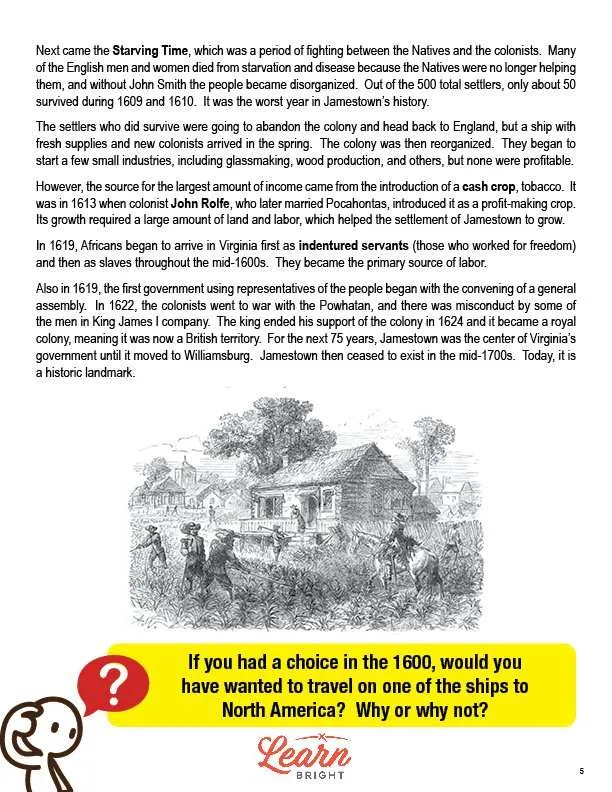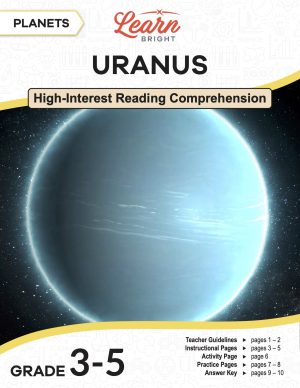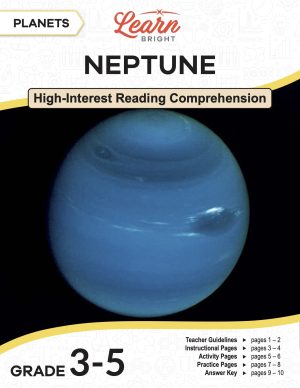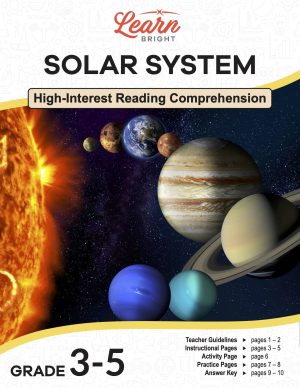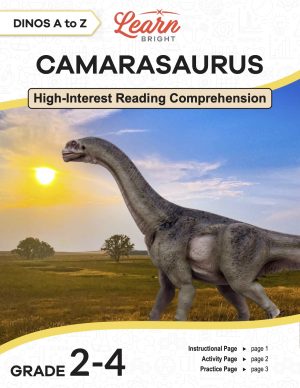Description
What our Jamestown lesson plan includes
Lesson Objectives and Overview: Jamestown lesson plan introduces students to the Jamestown settlement in 1607 and its significance to America and the original 13 colonies. Most students are aware of the 13 Original Colonies but often know little about the first permanent English settlement in North America. At the end of the lesson, students will be able to identify and locate the Jamestown settlement and explain its significance in the history of America. This lesson is for students in 3rd grade and 4th grade.
Classroom Procedure
Every lesson plan provides you with a classroom procedure page that outlines a step-by-step guide to follow. You do not have to follow the guide exactly. The guide helps you organize the lesson and details when to hand out worksheets. It also lists information in the orange box that you might find useful. You will find the lesson objectives, state standards, and number of class sessions the lesson should take to complete in this area. In addition, it describes the supplies you will need as well as what and how you need to prepare beforehand. To prepare for this lesson ahead of time, you can pair students for the activity and copy the handouts.
Options for Lesson
Included with this lesson is an “Options for Lesson” section that lists a number of suggestions for activities to add to the lesson or substitutions for the ones already in the lesson. An optional adjustment to the lesson activity is to assign each group a different question. For an additional lesson activity, you could invite a historian to speak to your class about the early expeditions to America. You can also discuss what life might have been like for the settlers and, especially, their children. You could display a world map and show your students the route to Jamestown from England. Another option is to allow students to access the internet and “visit” Jamestown that way. Finally, you can use coloring pages as an additional activity.
Teacher Notes
The teacher notes page includes a paragraph with additional guidelines and things to think about as you begin to plan your lesson. This page also includes lines that you can use to add your own notes as you’re preparing for this lesson.
JAMESTOWN LESSON PLAN CONTENT PAGES
Settlement in America
The Jamestown lesson plan includes three content pages. The lesson begins by asking students if they’ve ever wondered who, apart from the Native Americans, the first people in the Americas were. Why would people want to come to an unexplored place like America in the 1600s and why did they want to go to another country?
Many people visit America from other countries today, usually traveling via airplane. Before the 1600s, explorers from Europe traveled for weeks or months at a time on boats. They thought that unexplored lands had treasures and resources that they wanted. They also wanted to find other civilizations to trade with. Greenland’s Leif Eriksson (in around 1000), Christopher Columbus (in 1492), and many others traveled to North and South America.
Plymouth, Massachusetts was the first permanent English colony in North America, established in 1620 by the Plymouth Company. King James I established this colony in 1606 to establish settlements on the east coast of North America. The Pilgrims who traveled on the Mayflower settled there in the winter of 1620. These Pilgrims looked for religious freedom and they lived peacefully alongside the Native Americans. The 102 passengers traveled from three months from England to the new colony. Almost half of the people on the trip died while traveling or during the first winter.
This was not the first English settlement in America, though it did become the first permanent English colony. The first settlement was in Jamestown, Virginia in 1607. This settlement lasted for less than 100 years and failed in 1698.
The Founding of Jamestown
King James I financed an expedition to the Americas in 1606 with three ships, the Susan Constant, the Godspeed, and the Discovery. The ships carried 144 men, 39 crewmen and 109 settlers. They left from London on December 20, 1606 and first traveled south to the Canary Islands. From there, they went across the Atlantic to the Caribbean Islands, where they landed in modern-day Puerto Rico. They then traveled north and landed at Cape Henry in Virginia on April 26, 1607.
First, they had to decide where to place their fort for defense. They did not know what to expect so they chose an island and named the settlement Jamestown after King James. This was not a great spot for the settlement, because the summers were hot and swampy and the winters were cold.
The people expected to travel to America, find gold, get rich, and return to England. They did not know how to fish, hunt, or farm and had no survival skills. This made their first few years very difficult.
100 Years of Jamestown
More than half of the original settlers died in the first year of the settlement from disease, unsafe water, and starvation. The local Native Americans, the Powhatan people, also killed some settlers during battle. The Powhatan and a supply ship in January 1608 helped the surviving settlers. This supply ship also brought the first women to Jamestown.
Captain John Smith, elected in September 1608, was the fourth leader of Jamestown. He established a policy of “no work, no food” which meant that only the people who worked got to eat.
The Powhatan captured Smith at one point, but the chief’s daughter, Pocahontas, saved him. Smith then started trading with the Native American people. Smith returned to England in 1609 after injuring himself with gunpowder and never returned, although he did continue to help the development of the colony.
After this came the Starving Time, a period where the Native Americans and settlers fought. Many English men and women died from starvation and disease without the help of the Native Americans and the leadership of John Smith. Only 50 out of 500 people survived during 1609 and 1610. This was the worst year in the settlement’s history.
The remaining settlers planned to abandon the colony and return to England. However, a ship arrived with supplies and new colonists before they could leave. They reorganized the colony and started small industries like glassmaking, wood production, and others. None of these ventures were profitable.
They did find financial success with the cash crop tobacco. Colonist John Rolfe, who later married Pocahontas, introduced the crop in 1613. They needed lots of land and labor to grow it. In 1619, Africans arrived in Jamestown as indentured servants and later as slaves. They were the primary source of labor for the colony.
In 1619, they also started their first government with a general assembly. The colonists went to war with the Powhatan in 1622 and some of the men in King James I’s company acted badly. King James I cut off his support of the colony in 1624. It then became a royal colony, or British territory. Jamestown was the center of Virginia’s government for the next 75 years, until it moved to Williamsburg. It stopped existing in the mid-1700s and is a historic landmark today.
Key Terms
Here is a list of the vocabulary words students will learn in this lesson plan:
- Leif Eriksson: Explorer from Greenland in the year 1000
- Christopher Columbus: Traveled to the Americas in 1492
- Plymouth: First permanent English colony in America, 1620
- Pilgrims: People who settled first colony in Massachusetts
- Mayflower: Ship used by the Pilgrims in 1620
- Susan Constant, Godspeed, and Discovery: Three ships who carried men to America
- Cape Henry: Landing location in Virginia on April 26, 1607
- Powhatan: Native Americans people who fought and helped
- Captain John Smith: Leader who established a “no work, no food” policy
- Pocahontas: Powhatan chief’s daughter, married John Rolfe
- Starving Time: Period of fighting between Natives and colonists
- Cash crop: Type of plant; tobacco in Jamestown
- John Rolfe: Introduced tobacco and married Pocahontas
- Indentured servants: Servants who had to work for their freedom
JAMESTOWN LESSON PLAN WORKSHEETS
The Jamestown lesson plan includes three worksheets: an activity worksheet, a practice worksheet, and a homework assignment. You can refer to the guide on the classroom procedure page to determine when to hand out each worksheet.
TIME TRAVEL ACTIVITY WORKSHEET
Students will work with a partner to complete the lesson activity. Each pair will imagine that they go back in time as two of the first settlers in Jamestown. They will imagine that they are the two leaders of the colony. Using what they know about Jamestown’s history, they will decide what laws to create, what the settlers should be responsible for, and what they need to prepare for winter.
Students can work either alone or in groups for this activity if you’d like them to.
UNSCRAMBLE THE LETTERS PRACTICE WORKSHEET
For the practice worksheet, students will first unscramble the letters for different definitions or descriptions related to Jamestown. They will also list some advantages and disadvantages of the relationship between the Native Americans and the Jamestown and Plymouth settlers in North America in the 1600s.
JAMESTOWN HOMEWORK ASSIGNMENT
The homework assignment asks students to put ten events in chronological order. They will also answer three questions about the lesson material.
Worksheet Answer Keys
This lesson plan includes answer keys for the practice worksheet and the homework assignment. If you choose to administer the lesson pages to your students via PDF, you will need to save a new file that omits these pages. Otherwise, you can simply print out the applicable pages and keep these as reference for yourself when grading assignments.




